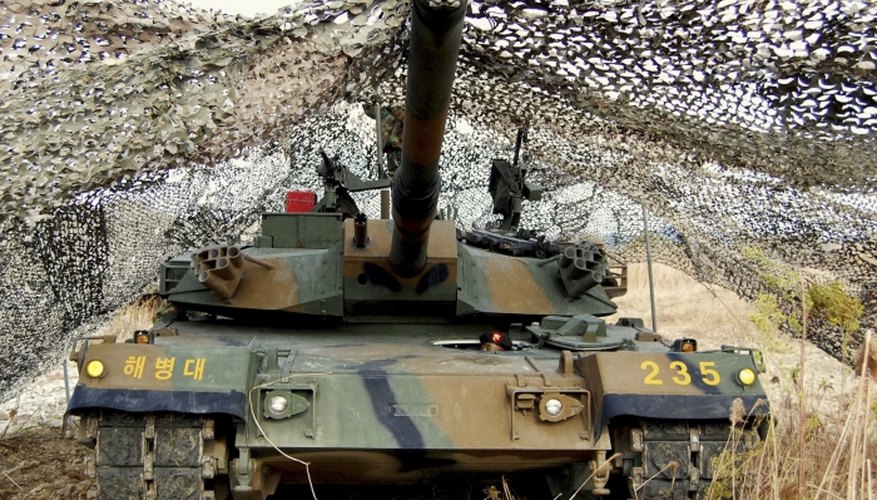Builders of 1/35 scale military models -- especially armour, trucks, cannon and personnel carriers -- often like to "weather" the models and add accessories to make them more realistic. Accessories can include items like shovels, ammo boxes, knapsacks and camouflage netting. The netting gives an effective look whether rolled up and stowed on a bumper or draped over a vehicle in a detailed diorama. Modellers can make their own camouflage netting that will fit 1/35 scale models.
- Builders of 1/35 scale military models -- especially armour, trucks, cannon and personnel carriers -- often like to "weather" the models and add accessories to make them more realistic.
Choose either surgical gauze or cheesecloth as a base for the scale model netting. Either will work for 1/35 scale. Modellers should experiment with both media to see which base provides the look they desire.
Cut a rectangle of the cloth to the desired size. Size will depend on whether the modeller wants the finished netting rolled up or spread over the model.
- Cut a rectangle of the cloth to the desired size.
- Size will depend on whether the modeller wants the finished netting rolled up or spread over the model.
Paint the cloth a base colour that reflects the combat area in which the modelled vehicle would have served. For instance, an Afrika Corps panzer from World War II would have sand- or tan-coloured base netting; a Soviet T-34 tank fighting in winter would have white base netting, and an American Sherman tank in France in the summer would have olive-drab base netting.
When the base is dry, camouflage the netting with various shades of paints that would match the tank's environment. Browns, blacks, greens and greys make good choices. Use either brushes or airbrushes to paint on the camouflaging. Refer to photographs of actual camouflage netting to get the designs correct.
Cut pieces of surgical or masking tape into short, thin rectangular strips to make "Hessian tape" camouflage or the more modern "barracuda" style netting. Barracuda netting, first used in World War II, has textile "tabs" attached to the netting to further break up the outline of the vehicle. Fix the tape over threads in the gauze or cheesecloth in an irregular pattern. When you are satisfied with the look, paint the tabs to fit your model's environment scheme.
- Cut pieces of surgical or masking tape into short, thin rectangular strips to make "Hessian tape" camouflage or the more modern "barracuda" style netting.
- Barracuda netting, first used in World War II, has textile "tabs" attached to the netting to further break up the outline of the vehicle.
Fashion loops from fine wire, loop them through sections of netting, and use super glue to attach to the vehicle. This will give the netting the look of "hanging" from the vehicle. Also effective, and historically accurate, is simply draping the netting over the vehicle. Remember that you are trying to achieve realism in the model, and men in combat will use easy and quick methods of camouflage.
In dioramas, use sticks or pieces of thin balsa wood to simulate "tent poles" that soldiers used to support camouflage netting tents over cannon. Such tents provided concealment for the guns and some sun protection for crews. Use sprue from model kits to simulate prefabricated modern tent poles.
Use tweezers or scissors to cut, pull or rip sections of the netting to simulate actual wear. Be sure to paint any white thread that may result from the cutting.
- In dioramas, use sticks or pieces of thin balsa wood to simulate "tent poles" that soldiers used to support camouflage netting tents over cannon.
- Use tweezers or scissors to cut, pull or rip sections of the netting to simulate actual wear.
To simulate rolled netting that might be tossed in the back of a Jeep or carried on a tank bumper, roll sections of finished netting, then wrap with cut strips of surgical or masking tape to simulate leather or fabric straps. Paint the straps matt brown or olive.
TIP
Consult photographs from magazines, books or the Internet to get your camouflage schemes correct. Also, make sure they are historically accurate. For example, a British desert design from World War II in 1941 may not be accurate for British armour in Iraq in 2003.
